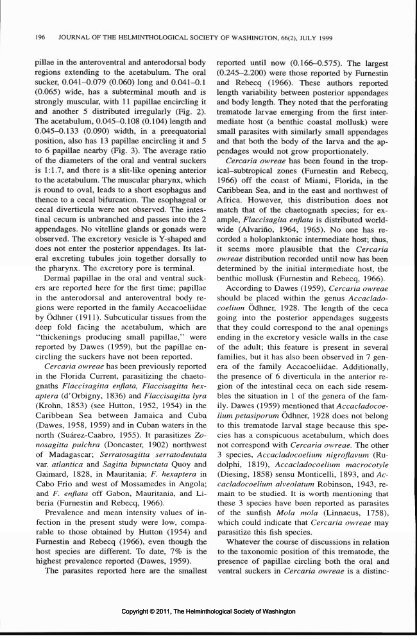The Helminthological Society of Washington - Peru State College
The Helminthological Society of Washington - Peru State College
The Helminthological Society of Washington - Peru State College
Create successful ePaper yourself
Turn your PDF publications into a flip-book with our unique Google optimized e-Paper software.
196 JOURNAL OF THE HELMINTHOLOGICAL SOCIETY OF WASHINGTON, 66(2), JULY 1999<br />
pillae in the anteroventral and anterodorsal body<br />
regions extending to the acetabulum. <strong>The</strong> oral<br />
sucker, 0.041-0.079 (0.060) long and 0.041-0.1<br />
(0.065) wide, has a subterminal mouth and is<br />
strongly muscular, with 11 papillae encircling it<br />
and another 5 distributed irregularly (Fig. 2).<br />
<strong>The</strong> acetabulum, 0.045-0.108 (0.104) length and<br />
0.045-0.133 (0.090) width, in a preequatorial<br />
position, also has 13 papillae encircling it and 5<br />
to 6 papillae nearby (Fig. 3). <strong>The</strong> average ratio<br />
<strong>of</strong> the diameters <strong>of</strong> the oral and ventral suckers<br />
is 1:1.7, and there is a slit-like opening anterior<br />
to the acetabulum. <strong>The</strong> muscular pharynx, which<br />
is round to oval, leads to a short esophagus and<br />
thence to a cecal bifurcation. <strong>The</strong> esophageal or<br />
cecal diverticula were not observed. <strong>The</strong> intestinal<br />
cecum is unbranched and passes into the 2<br />
appendages. No vitelline glands or gonads were<br />
observed. <strong>The</strong> excretory vesicle is Y-shaped and<br />
does not enter the posterior appendages. Its lateral<br />
excreting tubules join together dorsally to<br />
the pharynx. <strong>The</strong> excretory pore is terminal.<br />
Dermal papillae in the oral and ventral suckers<br />
are reported here for the first time; papillae<br />
in the anterodorsal and anteroventral body regions<br />
were reported in the family Accacoeliidae<br />
by Odhner (1911). Subcuticular tissues from the<br />
deep fold facing the acetabulum, which are<br />
"thickenings producing small papillae," were<br />
reported by Dawes (1959), but the papillae encircling<br />
the suckers have not been reported.<br />
Cercaria owreae has been previously reported<br />
in the Florida Current, parasitizing the chaetognaths<br />
Flaccisagitta enflata, Flaccisagitta hexaptera<br />
(d'Orbigny, 1836) and Flaccisagitta lyra<br />
(Krohn, 1853) (see Hutton, 1952, 1954) in the<br />
Caribbean Sea between Jamaica and Cuba<br />
(Dawes, 1958, 1959) and in Cuban waters in the<br />
north (Suarez-Caabro, 1955). It parasitizes Zonosagitta<br />
pulchra (Doncaster, 1902) northwest<br />
<strong>of</strong> Madagascar; Serratosagitta serratodentata<br />
var. atlantica and Sagitta bipunctata Quoy and<br />
Gaimard, 1828, in Mauritania; F. hexaptera in<br />
Cabo Frio and west <strong>of</strong> Mossamedes in Angola;<br />
and F. enflata <strong>of</strong>f Gabon, Mauritania, and Liberia<br />
(Furnestin and Rebecq, 1966).<br />
Prevalence and mean intensity values <strong>of</strong> infection<br />
in the present study were low, comparable<br />
to those obtained by Hutton (1954) and<br />
Furnestin and Rebecq (1966), even though the<br />
host species are different. To date, 7% is the<br />
highest prevalence reported (Dawes, 1959).<br />
<strong>The</strong> parasites reported here are the smallest<br />
reported until now (0.166-0.575). <strong>The</strong> largest<br />
(0.245-2.200) were those reported by Furnestin<br />
and Rebecq (1966). <strong>The</strong>se authors reported<br />
length variability between posterior appendages<br />
and body length. <strong>The</strong>y noted that the perforating<br />
trematode larvae emerging from the first intermediate<br />
host (a benthic coastal mollusk) were<br />
small parasites with similarly small appendages<br />
and that both the body <strong>of</strong> the larva and the appendages<br />
would not grow proportionately.<br />
Cercaria owreae has been found in the tropical-subtropical<br />
zones (Furnestin and Rebecq,<br />
1966) <strong>of</strong>f the coast <strong>of</strong> Miami, Florida, in the<br />
Caribbean Sea, and in the east and northwest <strong>of</strong><br />
Africa. However, this distribution does not<br />
match that <strong>of</strong> the chaetognath species; for example,<br />
Flaccisagita enflata is distributed worldwide<br />
(Alvarino, 1964, 1965). No one has recorded<br />
a holoplanktonic intermediate host; thus,<br />
it seems more plausible that the Cercaria<br />
owreae distribution recorded until now has been<br />
determined by the initial intermediate host, the<br />
benthic mollusk (Furnestin and Rebecq, 1966).<br />
According to Dawes (1959), Cercaria owreae<br />
should be placed within the genus Accacladocoelium<br />
Odhner, 1928. <strong>The</strong> length <strong>of</strong> the ceca<br />
going into the posterior appendages suggests<br />
that they could correspond to the anal openings<br />
ending in the excretory vesicle walls in the case<br />
<strong>of</strong> the adult; this feature is present in several<br />
families, but it has also been observed in 7 genera<br />
<strong>of</strong> the family Accacoeliidae. Additionally,<br />
the presence <strong>of</strong> 6 diverticula in the anterior region<br />
<strong>of</strong> the intestinal ceca on each side resembles<br />
the situation in 1 <strong>of</strong> the genera <strong>of</strong> the family.<br />
Dawes (1959) mentioned that Accacladocoeliurn<br />
petasiporum Odhner, 1928 does not belong<br />
to this trematode larval stage because this species<br />
has a conspicuous acetabulum, which does<br />
not correspond with Cercaria owreae. <strong>The</strong> other<br />
3 species, Accacladocoelium nigr<strong>of</strong>lavum (Rudolphi,<br />
1819), Accacladocoelium macrocotyle<br />
(Diesing, 1858) sensu Monticelli, 1893, and Accacladocoelium<br />
alveolatum Robinson, 1943, remain<br />
to be studied. It is worth mentioning that<br />
these 3 species have been reported as parasites<br />
<strong>of</strong> the sunfish Mola mola (Linnaeus, 1758),<br />
which could indicate that Cercaria owreae may<br />
parasitize this fish species.<br />
Whatever the course <strong>of</strong> discussions in relation<br />
to the taxonomic position <strong>of</strong> this trematode, the<br />
presence <strong>of</strong> papillae circling both the oral and<br />
ventral suckers in Cercaria owreae is a distinc-<br />
Copyright © 2011, <strong>The</strong> <strong>Helminthological</strong> <strong>Society</strong> <strong>of</strong> <strong>Washington</strong>
















